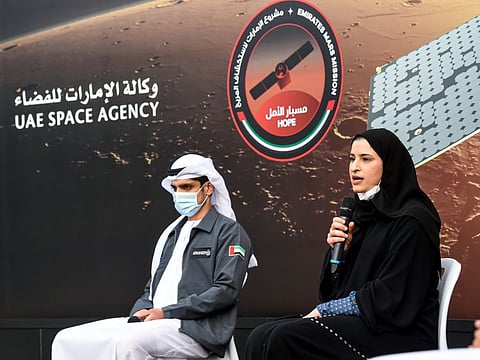UAE Mars Mission: Hope Probe is healthy and ready to move to Science phase
First image of Mars from Hope Probe to be released in one week

Dubai: The most difficult part is over — Hope Probe has successfully entered Mars and will soon transition to its Science phase to begin its core mission of studying the atmosphere of the Red Planet.
On Wednesday, a day after the successful Mars Orbit Insertion (MOI), Omran Sharaf, Emirates Mars Mission Project Director, met the press and said the orbiter is in good health. “We have checked Hope Probe this morning and all subsystems are working fine. We have finished the most critical and harsh operation (MOI) and we have begun the transition from MOI to orbit phase,” he said.
After Hope Probe’s successfully orbit entry, scientists and engineers will spend two months testing the spacecraft and its on-board scientific instruments before the orbiter will transition to its science orbit. The transition from capture orbit to science orbit will happen for two months. During this phase, all instruments on board Hope Probe will be calibrated to ensure data that will collected are accurate. The ground control at Mohamme bin Rashid Space Centre (MBRSC) will conduct Three Transition to Science (TTS) manoeuvres to move the probe from its capture to science orbit.
First image from Hope
Hope Probe, however, is expected to send the first image of Mars — independent of its science mission — in one week, noted Sharaf.
The transition to Hope’s science orbit will be completed by April 2021. Hope Probe will be at its nearest point or periapsis with Mars surface at a distance of 1,000km and apoapsis or farthest point at 49,380km. Hope has a planned 20,000-43,000km elliptical science orbit, with an inclination to Mars of 25 degrees. In this orbit, the probe completes one orbit of the planet every 55 hours and will capture a full planetary sample every nine days.
The first set of data that will be released to the scientific community and the public will be by September, Omran Ahmed Al Hammadi, Science Data Centre Lead — Hope Probe, earlier told Gulf News. “The mission operation centre at different ground stations spread around the world will receive raw data from Hope Probe, which will be submitted to the Science Data Centre at MBRSC, where data processing, management and indexing will be done. It will take 30 minutes to process the data and the first set of data will be released by September and every three months thereafter,” he added.
Crucial moments
Recalling the most critical phase during Hope Probe’s journey, Sharaf said the MOI commenced at 7:30pm (UAE time). The spacecraft worked autonomously as all commands have been programmed. Hope Probe fired its six Delta V thrusters to rapidly reduce its speed from 121,000km/h to 18,000km/h. The deceleration burn took 27 minutes and by 7.57pm, the probe was safely captured by Mars orbit.
At 8:08pm, the ground control station at Al Khawaneej received the first transmission from Hope Probe and Sharaf declared to the UAE and the world the success of the mission.
“Everything went as planned,” noted Sarah Al Amiri, Minister of State for Advanced Technology and Chairman of the UAE Space Agency.
New methodology in space technology
Al Amiri said the success of Hope Probe has added a new methodology in space design and technology. “We have tested different scenarios and modified designs of previous missions to achieve success and we’re grateful everything went as planned,” she added.
When asked if there is a plan to expand the current Mars programme, Al Amiri said there is no plan yet to send a rover or a lander to Mars. “Let’s focus first on the core mission of Hope Probe and let us start its scientific phase,” she explained.
What’s next for Hope Probe
Daily contact with Hope Probe will be established for the next three to four weeks to enable a quick turnaround of command sequence uploads and telemetry receipt. The probe will capture its first picture of Mars in the first week of its arrival.
The rebooting of the probe’s systems can last for 45 days, while the radio signals will take a total of 22 minutes to travel from Hope to Earth and back. The three science instruments installed on the probe will enable the collection of 1,000GB comprehensive new Martian data, which will be shared for free with over 200 research centres across the world.
Sign up for the Daily Briefing
Get the latest news and updates straight to your inbox







